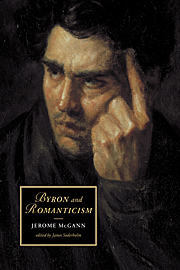Book contents
- Frontmatter
- Contents
- Acknowledgments
- General analytical and historical introduction
- PART I
- 1 Milton and Byron
- 2 Byron, mobility, and the poetics of historical ventriloquism
- 3 “My brain is feminine”: Byron and the poetry of deception
- 4 What difference do the circumstances of publication make to the interpretation of a literary work?
- 5 Byron and the anonymous lyric
- 6 Private poetry, public deception
- 7 Hero with a thousand faces: the rhetoric of Byronism
- 8 Byron and the lyric of sensibility
- 9 Byron and Wordsworth
- PART II
- Subject index
- Authors index
- CAMBRIDGE STUDIES IN ROMANTICISM
3 - “My brain is feminine”: Byron and the poetry of deception
Published online by Cambridge University Press: 22 September 2009
- Frontmatter
- Contents
- Acknowledgments
- General analytical and historical introduction
- PART I
- 1 Milton and Byron
- 2 Byron, mobility, and the poetics of historical ventriloquism
- 3 “My brain is feminine”: Byron and the poetry of deception
- 4 What difference do the circumstances of publication make to the interpretation of a literary work?
- 5 Byron and the anonymous lyric
- 6 Private poetry, public deception
- 7 Hero with a thousand faces: the rhetoric of Byronism
- 8 Byron and the lyric of sensibility
- 9 Byron and Wordsworth
- PART II
- Subject index
- Authors index
- CAMBRIDGE STUDIES IN ROMANTICISM
Summary
I begin with a mouldy anecdote, a late supplement to that once-flourishing industry – now part of the imagination's rust belt – called “Curiosities of Literature.”
In 1894 a short article appeared in Notes and Queries under the heading “Byroniana.” Its subject was a poem entitled “The Mountain Violet” which the author of the article, Henry Wake, attributed to Byron. The case for authenticity was argued on two counts, one archival and one stylistic. The archival argument observed that the poem was printed in an anthology of verse collected by one Charles Snart under the title A Selection of Poems, published in Newark in two volumes in 1807–1808. Wake said that he was in possession of a set of Snart's edition with “Mrs. Byron” written in pencil in her hand on the front flyleaf, and with the following notation on the end flyleaf of Volume II: “66 from Nottingham Journal.” The latter was a reference to “The Mountain Violet,” which was printed on page 66 of Vol. II. The poem, it turns out, was in fact first printed in the Nottingham Journal on 9 April 1803. Neither printing attributes authorship, but according to Wake the pencil notation at the end of Snart's book is in Byron's hand.
Wake went on to argue that the poem's style showed remarkable congruities with the style of Byron's early verse. Such matters are difficult to decide, of course, especially when one is dealing with juvenilia.
- Type
- Chapter
- Information
- Byron and Romanticism , pp. 53 - 76Publisher: Cambridge University PressPrint publication year: 2002
- 1
- Cited by

